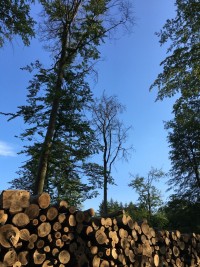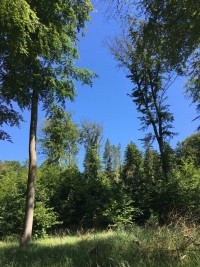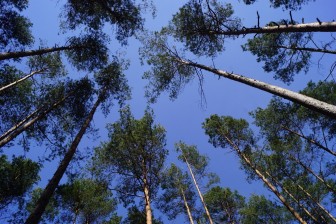Study in northern Germany: forestry contributed to forest warming during extreme summers
In extremely hot and dry years, it is not only weather that influences forest vitality. Forest use can significantly reduce the cooling capacity of forests and thus increase the sensitivity of forests to climate change. In the flora-fauna-habitat (FFH) area "Forests near Feldberg with Breiter Luzin and Dolgener See" in the neighbourhood of the forest ‚ÄėHeilige Hallen‚Äô, Mecklenburg-Vorpommern, mainly old exposed beech trees have been dying after forestry interventions for several years, June 2020.
Photo: Jeanette Blumröder
Pine plantation with an open canopy in Brandenburg, Germany.
Photo: Pierre Ibisch
In a heavily thinned beech forest with a disintegrated canopy and interspersed with logging roads, the microclimatic regulation that is characteristic of forests is lost. This leads to severe heat and drought-induced damage and the dieback of old exposed trees in particular. The Special Area of Conservation established under the EU Habitats Directive "Forests near Feldberg with Breiter Luzin and Dolgener See" in the neighbourhood of the forest ‚ÄėHeilige Hallen‚Äô, Mecklenburg-Western Pomerania, June 2021.
Photo: Jeanette Blumröder
In a study published in the journal Ecological Solutions and Evidence of the British Ecological Society together with colleagues from Leuphana University in Lueneburg and the Free University of Berlin, scientists from Eberswalde University for Sustainable Development (EUSD) show that forestry use has a significant influence on the cooling capacity of forests and thus on their sensitivity to climate change.
Forest ecosystems influence climate on global and local scales. One important feature of forests is the regulation of ecosystem microclimate. Shading by trees, evaporation of water, storage of heat in biomass, and energy conversion through photosynthesis cause forests to cool themselves and their surroundings during hot weather. This can prevent damaging maximum temperatures, especially during prolonged heat waves.
The scientist responsible for the study, Jeanette Blumröder, EUSD, states, "Increased logging and a correspondingly greater opening of the canopy drive up the maximum temperatures in the forest. This also increases the vulnerability of forests to climate change. The extensive series of measurements in beech forests and pine forests in northern Germany from the heat summers of 2018 and 2019 confirm very concretely the fears that emerged from previous studies. When the canopy is opened by 10 %, average maximum temperatures increase by about half a degree Celsius. Pine forests show below average cooling capacity once the canopy is less than 82 % closed."
In biomass-poor pine plantations (177 m3 per hectare), the average maximum temperature was 9¬įC higher than in relatively biomass-rich beech forests (> 565 m3 per hectare). When pine plantations alone are considered, a significant influence of use intensity is also evident: during the hottest day in 2019, the difference in peak temperatures between those with a relatively dense canopy (72 %) and those with a particularly open one (46 %) was more than 13¬įC.
Project leader Prof. Dr. Pierre Ibisch summarizes, "The conclusion is that forest managers therefore have some control in climate change over how much the forests entrusted to them heat up and are potentially damaged as a result. Higher biomass stocks and a closed canopy are insurance against extreme weather."
The paper also critically discusses and casts doubt on previously common silvicultural recommendations to promote forest thinning. Water losses and the risk of heat damage increase with thinning. The authors recommend to keep the canopy as closed as possible (at least 80 %) and to use the forests accordingly cautiously. In addition, they confirm the well-known demand to develop the simply structured conifer monocultures into structurally rich mixed deciduous forests as quickly as possible. Forest managers should live up to their outstanding responsibility for landscape temperature management in climate change.
The study was significantly funded by the project "Ecological and economic assessment of integrated nature conservation measures in forest management to secure ecosystem services and forest ecosystem functions (Gläserner Forst) - Subproject 3: Ecological assessment and ecosystem services" of the German Federal Ministry of Education and Research (BMBF). Project partners are the Brandenburg Ministry of the Environment, the University of Göttingen and Naturschutzbund Deutschland e.V. (NABU). The forests studied are located, among others, in the Schorfheide-Chorin Biosphere Reserve and on areas of the NABU Foundation National Natural Heritage in Brandenburg, as well as in the Heilige Hallen Conservation Area in Mecklenburg-Western Pomerania.
Original study: Blumroeder, Jeanette S., Felix May, Werner Härdtle, and Pierre L. Ibisch (2021) Forestry contributed to warming of forest ecosystems in northern Germany during the extreme summers of 2018 and 2019. Ecological Solutions and Evidence. DOI 10.1002/2688-8319.12087. Link to the article and the journal: https://besjournals.onlinelibrary.wiley.com/doi/10.1002/2688-8319.12087
Authors:
Jeanette Silvin Blumröder & Prof. Dr. Pierre L. Ibisch
Centre for Econics and Ecosystem Management, Eberswalde University for Sustainable Development
Dr. Felix May
AG Theoretische Biologie, Institut f√ľr Biologie, Freie Universit√§t Berlin
Prof. Dr. Werner Härdtle
Institut f√ľr √Ėkologie, Leuphana Universit√§t L√ľneburg
Hier klicken, um zur deutschen Version zu gelangen.
For further questions, please contact:
Expert contact
Prof. Dr. Pierre Ibisch
Professor for Nature Conservation
Tel.: +49 3334 657-178
pierre.ibisch@hnee.de
Press contact
Corinna Hartwig
Communications and media relations
Tel.: +49 3334 657-227
presse@hnee.de
About Eberswalde University for Sustainable Development (EUSD)
Connecting with Nature for the benefit of Humans.
EUSD is a nationally and internationally active impulse generator for sustainable development. Around 2,300 students from 57 countries study and more than 350 employees research, teach and work at the university in the midst of an extensive natural landscape just outside Berlin. In the four faculties of Forest and Environment, Landscape Use and Conservation, Wood Engineering and Sustainable Economy, students can obtain skills in fields such as nature conservation, forest ecosystem management, organic agriculture, adaptation to climate change, sustainable economy, timber construction or sustainable tourism management in currently 20 study programmes, some of which are unique in Germany.













